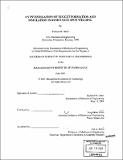An investigation of nugget formation and simulation in resistance spot welding
Author(s)
Obert, Richard M. (Richard Matthew), 1977-
DownloadFull printable version (7.547Mb)
Other Contributors
Massachusetts Institute of Technology. Dept. of Mechanical Engineering.
Advisor
Jung-Hoon Chun.
Terms of use
Metadata
Show full item recordAbstract
Resistance spot welding is an important part of the automotive manufacturing industry. Today's automobiles typically contain five-thousand or more welds. Spot welding is attractive to the industry for its speed and relative simplicity, however, it is not without its disadvantages. Current spot welding technology relies on volumes of empirical data to set the welding parameters. Often this data is not sufficient to ensure that a nugget of sufficient size is formed without a splash occurring. Complicating the matter further is the industry's increased use of coated steel. The chemical reaction of the coatings with the electrodes cause greater variations in the nugget size. This study seeks to characterize the nugget formation patterns of spot welding for a variety of welding materials and welding conditions. Specifically for coated steels welded over long periods with the same electrodes. The study also seeks to relate a small set of monitored parameters during welding to the accurate prediction of nugget size and splash occurrence. Welding current and voltage are identified as the key parameters of interest and are used as input to a numerical simulation to predict nugget diameter. A comparison of the simulated nugget diameters to actual diameters obtained experimentally show good agreement between the two values. The simulation, however, uses a finite difference method to obtain the nugget diameter. This method requires extensive calculations that cannot be completed in the normal welding time. Therefore, a new method of splash prediction has been investigated using the mean temperature of the workpiece. The mean temperature is obtained from a heat balance model of the workpiece. The heat balance model is advantageous to the finite difference simulation because its calculation time is short enough to be carried out during the welding process. A comparison of the maximum mean temperature and the experimental nugget diameters shows that mean temperature is capable of predicting nugget diameter. This correlation indicates that the mean temperature value can serve as a splash prediction parameter.
Description
Thesis (S.M.)--Massachusetts Institute of Technology, Dept. of Mechanical Engineering, 2001. Includes bibliographical references (leaf 117).
Date issued
2001Department
Massachusetts Institute of Technology. Department of Mechanical EngineeringPublisher
Massachusetts Institute of Technology
Keywords
Mechanical Engineering.